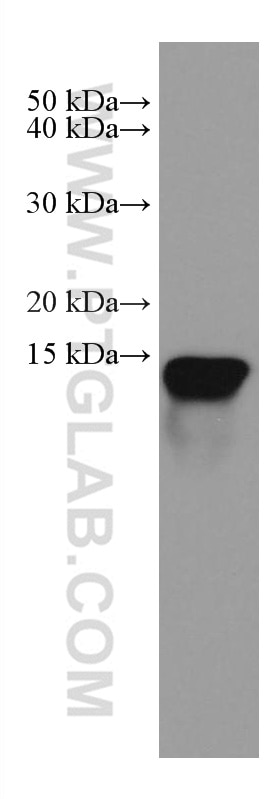Tested Applications
| Positive WB detected in | HL-60 cells, Human peripheral blood leukocyte |
Recommended dilution
| Application | Dilution |
|---|---|
| Western Blot (WB) | WB : 1:2000-1:6000 |
| It is recommended that this reagent should be titrated in each testing system to obtain optimal results. | |
| Sample-dependent, Check data in validation data gallery. | |
Product Information
67581-1-Ig targets Galectin 10 in WB, ELISA applications and shows reactivity with human samples.
| Tested Reactivity | human |
| Host / Isotype | Mouse / IgG1 |
| Class | Monoclonal |
| Type | Antibody |
| Immunogen |
CatNo: Ag18569 Product name: Recombinant human CLC protein Source: e coli.-derived, PGEX-4T Tag: GST Domain: 1-142 aa of BC119711 Sequence: MSLLPVPYTEAASLSTGSTVTIKGRPLVCFLNEPYLQVDFHTEMKEESDIVFHFQVCFGRRVVMNSREYGAWKQQVESKNMPFQDGQEFELSISVLPDKYQVMVNGQSSYTFDHRIKPEAVKMVQVWRDISLTKFNVSYLKR Predict reactive species |
| Full Name | Charcot-Leyden crystal protein |
| Calculated Molecular Weight | 142 aa, 16 kDa |
| Observed Molecular Weight | 16 kDa |
| GenBank Accession Number | BC119711 |
| Gene Symbol | Galectin 10 |
| Gene ID (NCBI) | 1178 |
| RRID | AB_2882792 |
| Conjugate | Unconjugated |
| Form | Liquid |
| Purification Method | Protein G purification |
| UNIPROT ID | Q05315 |
| Storage Buffer | PBS with 0.02% sodium azide and 50% glycerol, pH 7.3. |
| Storage Conditions | Store at -20°C. Stable for one year after shipment. Aliquoting is unnecessary for -20oC storage. 20ul sizes contain 0.1% BSA. |
Background Information
Galectin-10 (Gal-10), also called Charcot-Leyden Crystal (CLC) protein, is a member of the galectin superfamily of galactoside-binding lectins and is most prominently expressed in human eosinophils, where it forms the classic hexagonal bipyramidal Charcot-Leyden crystals that are considered hallmarks of eosinophilic inflammatory reactions
Protocols
| Product Specific Protocols | |
|---|---|
| WB protocol for Galectin 10 antibody 67581-1-Ig | Download protocol |
| Standard Protocols | |
|---|---|
| Click here to view our Standard Protocols |






